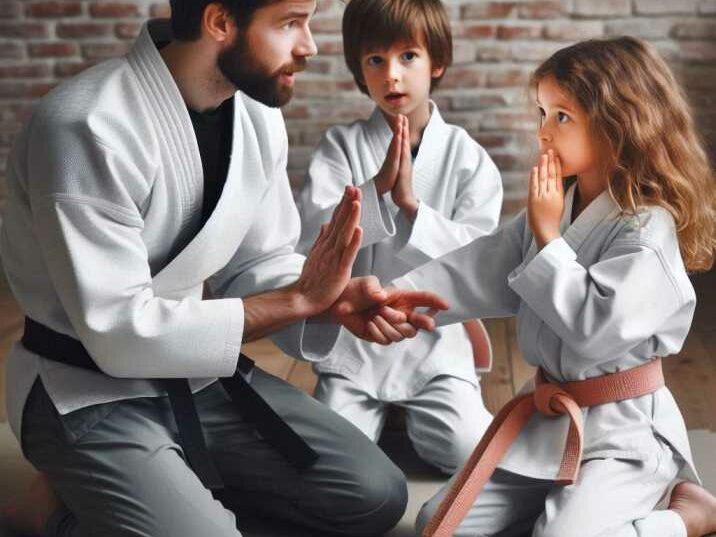Bullying is a widespread issue that affects children across the globe. Understanding and utilizing anti-bullying techniques and self-defense strategies taught in martial arts can empower kids to handle these situations effectively. Martial arts not only teach physical defense skills but also instill confidence, respect, and self-discipline. In this article, we will delve into various practical techniques that martial arts offer to help kids avoid and respond to bullying situations.

Table of Contents
- Introduction to Anti-Bullying Techniques in Martial Arts
- Building Confidence and Awareness
- Verbal Self-Defense Strategies
- Physical Self-Defense Techniques
- Role of Discipline and Respect in Martial Arts
- Benefits of Martial Arts Beyond Self-Defense
- How to Choose the Right Martial Art for Your Child
- Real-Life Success Stories
- Historical Context of Martial Arts and Anti-Bullying
- Psychological Benefits of Martial Arts
- Parent and Community Involvement
- Comparative Analysis of Different Martial Arts
- Common Misconceptions About Martial Arts and Self-Defense
- Resources and Further Reading
- Frequently Asked Questions
Introduction to Anti-Bullying Techniques in Martial Arts
Table of Contents
Anti-bullying techniques and self-defense taught in martial arts are more than just physical maneuvers. They include a combination of psychological preparedness, verbal de-escalation, and, when necessary, physical defense. Martial arts like Karate, Taekwondo, Judo, and Brazilian Jiu-Jitsu provide comprehensive training that can help children manage bullying effectively.
Building Confidence and Awareness
One of the first things kids learn in martial arts is confidence. Confidence acts as a deterrent against bullies who often target those who seem vulnerable. In martial arts classes, children practice assertive body language, such as maintaining eye contact and standing tall, which can help them project confidence.
Additionally, martial arts emphasize situational awareness. Kids are taught to be mindful of their surroundings and to recognize potential threats early. This awareness helps them avoid dangerous situations before they escalate. For instance, knowing the quickest escape routes or identifying safe spaces can be crucial in avoiding bullying scenarios.
Verbal Self-Defense Strategies
Verbal self-defense is a key component of martial arts training. It involves using words to defuse or de-escalate a situation. Techniques include:
- Assertive Communication: Martial arts teach children how to use a firm, clear voice to assertively communicate their boundaries. This might involve saying, “Stop, I don’t like that,” or “Leave me alone.”
- Humor and Distraction: Sometimes, using humor or changing the subject can diffuse tension. Martial arts instructors might role-play different scenarios with kids to practice these techniques.
- Seeking Help: Kids are encouraged to know when and how to seek help from adults, whether it’s a teacher, parent, or another trusted individual.
Physical Self-Defense Techniques
When verbal strategies fail, physical self-defense techniques come into play. Martial arts provide a variety of non-violent techniques to protect oneself:
- Breakaway Techniques: These involve learning how to escape from holds and grabs. For example, if a bully grabs a child’s wrist, martial arts teach specific maneuvers to break free without causing harm.
- Blocking and Parrying: Kids learn how to block punches or kicks effectively. This skill is crucial for protecting themselves while minimizing the need for offensive moves.
- Safe Falling and Rolling: In arts like Judo, children learn how to fall safely to avoid injury, which can be particularly useful if pushed or tripped.
- Basic Strikes and Kicks: While physical confrontation is a last resort, knowing how to deliver basic strikes and kicks can be crucial if a situation becomes physically dangerous. Kids are taught to aim for non-lethal areas and to use these techniques only when absolutely necessary.
Role of Discipline and Respect in Martial Arts
Discipline and respect are core tenets of martial arts. Children learn the importance of respecting others and understanding the consequences of their actions. This ethical framework discourages them from becoming bullies themselves and encourages a supportive environment.
Furthermore, the disciplined practice of martial arts builds self-control, which helps children manage their emotions and reactions in stressful situations. This self-regulation is critical in handling bullying without resorting to aggression.
Benefits of Martial Arts Beyond Self-Defense
Martial arts offer numerous benefits beyond self-defense, including:
- Physical Fitness: Regular practice improves strength, flexibility, and overall health.
- Mental Focus: Martial arts require concentration, which can enhance a child’s academic performance and attention span.
- Social Skills: Training often involves teamwork and cooperation, helping kids build friendships and social networks.
- Emotional Resilience: Learning to handle success and failure in training builds emotional resilience, helping kids cope with challenges.
How to Choose the Right Martial Art for Your Child
Choosing the right martial art for your child depends on several factors, including their interests, personality, and physical abilities. Here are some tips to help you decide:
- Research Different Martial Arts: Each martial art has its own philosophy and techniques. For example, Karate focuses on strikes, Taekwondo emphasizes kicks, Judo involves throws and grappling, and Brazilian Jiu-Jitsu specializes in ground fighting.
- Visit Local Dojos: Attend classes at local martial arts schools to see which environment and teaching style your child responds to best. Speak with instructors to understand their approach to teaching kids.
- Consider Your Child’s Goals: If your child is interested in self-defense, confidence-building, or physical fitness, different martial arts may suit their needs better. Discuss these goals with potential instructors.
- Trial Classes: Many martial arts schools offer trial classes. Enroll your child in a few different ones to see which they enjoy the most and where they feel most comfortable.
Real-Life Success Stories
To illustrate the effectiveness of martial arts in dealing with bullying, let’s look at some real-life success stories:
Case Study 1: Sarah’s Journey with Karate Sarah, a shy 10-year-old, struggled with bullying at school. Her parents enrolled her in a local Karate class to build her confidence. Within a few months, Sarah learned how to stand up for herself verbally and physically. Her newfound confidence made her less of a target, and she developed a supportive group of friends at her dojo.
Case Study 2: James and Brazilian Jiu-Jitsu James, a 12-year-old, faced physical bullying on the playground. His parents chose Brazilian Jiu-Jitsu for its focus on grappling and ground defense. James learned how to control his opponents without hurting them. This skill not only protected him from harm but also earned him respect from his peers, leading to a significant decrease in bullying incidents.
Historical Context of Martial Arts and Anti-Bullying
Martial arts have a rich history that dates back thousands of years. Originally developed for self-defense and military purposes, many martial arts have evolved to emphasize personal growth and non-violent conflict resolution. For instance, Judo, founded by Jigoro Kano in the late 19th century, was created with the philosophy of “maximum efficiency with minimum effort” and aims to develop physical and mental discipline without inflicting harm.
In ancient China, Kung Fu was practiced not just for combat but also for self-discipline and moral development. Similarly, Karate, which originated in Okinawa, Japan, promotes principles of respect, perseverance, and humility. These historical roots underscore the importance of martial arts in developing a balanced approach to self-defense and personal integrity, making them particularly relevant in addressing bullying.
Psychological Benefits of Martial Arts
Martial arts training goes beyond physical conditioning; it significantly impacts a child’s psychological well-being. Here are some psychological benefits:
- Improved Self-Esteem: Consistent training and achieving new skills boost a child’s self-esteem and confidence. This newfound confidence often deters bullies, who typically prey on perceived weaknesses.
- Stress Relief: Physical activity, combined with the disciplined breathing techniques taught in martial arts, helps reduce stress and anxiety. Children learn to manage their emotions better, which is crucial in bullying situations.
- Enhanced Focus: The repetitive nature of martial arts training improves focus and concentration, helping children with ADHD and other attention disorders.
- Resilience and Grit: Martial arts teach perseverance. Children learn to push through challenges and failures, developing resilience and grit that benefit them in all areas of life.
Parent and Community Involvement
Parents and the community play a vital role in reinforcing the anti-bullying techniques and values taught in martial arts. Here are ways parents and communities can get involved:
- Supportive Environment: Parents should create a supportive environment at home where children feel safe discussing their experiences with bullying.
- Community Programs: Community centers and schools can collaborate with local martial arts schools to offer self-defense workshops and anti-bullying programs.
- Positive Reinforcement: Encourage children to practice the skills and values they learn in martial arts in their daily lives. Positive reinforcement helps reinforce these behaviors.
- Open Communication: Maintain open lines of communication with instructors to stay informed about your child’s progress and any areas that need attention.
Comparative Analysis of Different Martial Arts
Each martial art offers unique benefits and focuses on different aspects of self-defense and personal development. Here’s a comparative analysis:
- Karate: Emphasizes strikes, kicks, and defensive blocking techniques. It promotes discipline, respect, and self-control.
- Taekwondo: Known for its high, fast kicks and jumping, spinning kicks. It builds strength, agility, and balance.
- Judo: Focuses on throws, pins, and submissions. It teaches leverage and balance and promotes the principle of using an opponent’s strength against them.
- Brazilian Jiu-Jitsu: Specializes in ground fighting and submission holds. It is effective for self-defense in close-combat situations and teaches control without reliance on strength.
- Kung Fu: Incorporates fluid movements and forms. It emphasizes flexibility, coordination, and the integration of mind and body.
Common Misconceptions About Martial Arts and Self-Defense
There are several misconceptions about martial arts and self-defense that need to be addressed:
- Martial Arts Promote Violence: Contrary to this belief, martial arts teach self-control, respect, and non-violent conflict resolution. Physical techniques are a last resort.
- Martial Arts Are Only for Boys: Martial arts are for everyone. Many girls find empowerment and confidence through martial arts training.
- You Need to Be Physically Strong: Martial arts techniques often rely on leverage, timing, and strategy rather than brute strength, making them accessible to children of all sizes and strengths.
- Martial Arts Are Only About Fighting: Martial arts are holistic, focusing on mental, emotional, and physical development. They teach valuable life skills beyond fighting.
Conclusion
Martial arts provide children with essential tools to combat bullying through confidence-building, situational awareness, and self-discipline. These skills help kids defend themselves both verbally and physically, promoting a well-rounded approach to handling bullying.
Beyond self-defense, martial arts teach respect, perseverance, and emotional control, contributing to overall personal development. Parents and communities play a vital role in supporting children by creating a positive environment and encouraging consistent practice.
Ultimately, martial arts empower children to stand up for themselves and build resilience. By choosing the right martial art and fostering a supportive atmosphere, parents can help their children navigate bullying challenges with strength and confidence.
Frequently Asked Questions
1. What age should children start learning martial arts for self-defense?
Children can start learning martial arts as early as four or five years old. Early training helps them develop motor skills, discipline, and confidence.
2. How do martial arts help with bullying outside of physical defense?
Martial arts teach kids verbal self-defense, situational awareness, and emotional control, all of which are crucial for handling bullying without resorting to physical conflict.
3. Are martial arts safe for kids?
Yes, martial arts are generally safe for kids when taught by qualified instructors. Safety measures and age-appropriate training ensure children learn in a secure environment.
4. Can martial arts make my child aggressive?
No, martial arts focus on self-control, respect, and discipline. They teach children to use their skills responsibly and to avoid conflict whenever possible.
5. What type of martial art is best for self-defense against bullying?
Any martial art can be effective for self-defense. Arts like Karate, Taekwondo, and Brazilian Jiu-Jitsu are popular choices because they offer a balance of physical and verbal defense techniques.


